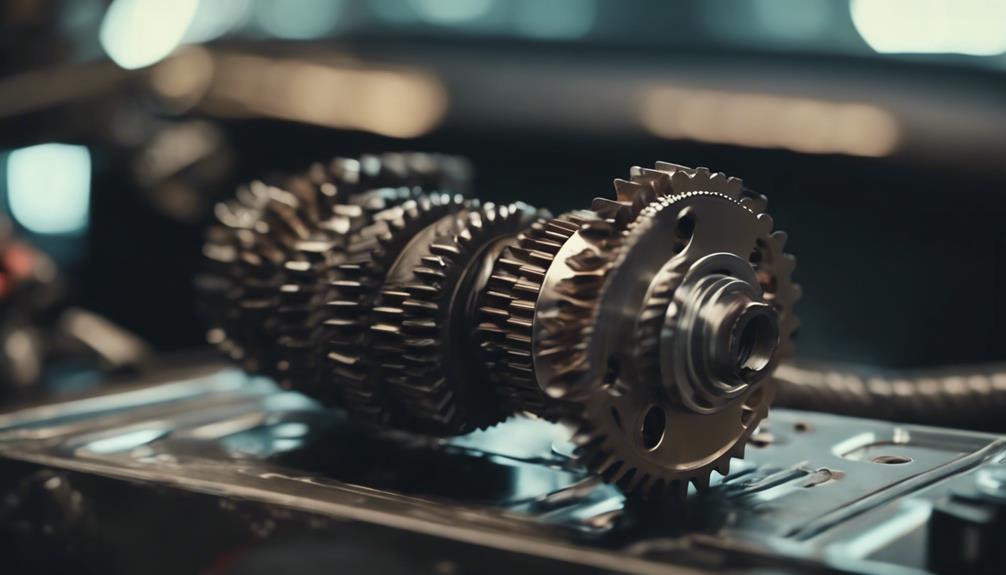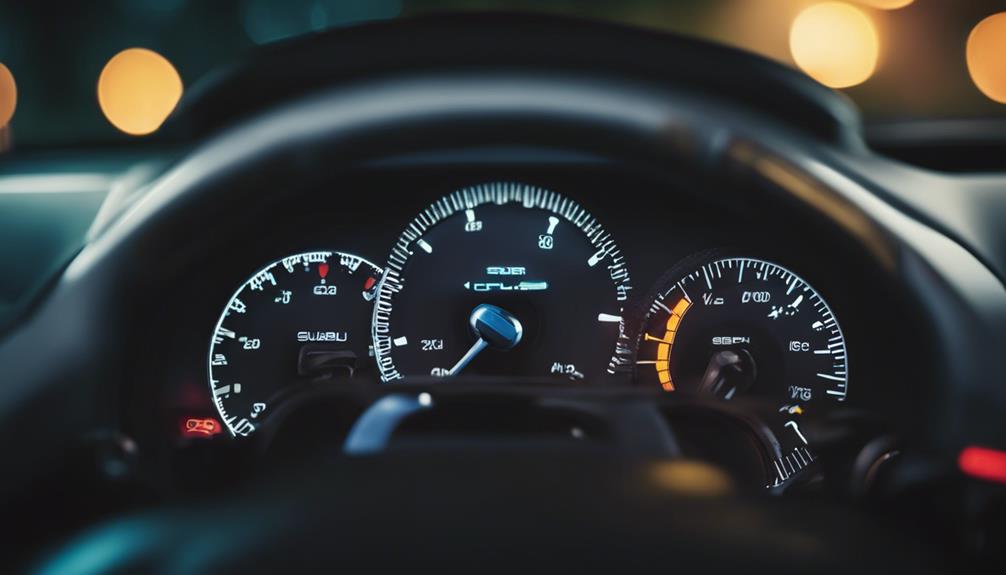Transmission slipping occurs when gears fail to engage properly, affecting acceleration and gear shifting. This issue, common in both manual and automatic transmissions, can be caused by low fluid levels or worn-out components like clutch assemblies. Symptoms include high RPM, delayed acceleration, and difficulty switching gears. Ignoring these signs can lead to costly repairs and safety hazards. Proper diagnosis through fluid analysis and visual inspections is essential for effective resolution. To prevent slipping, regularly check fluid levels, service the transmission, and address leaks promptly. Maintaining your vehicle diligently can help catch slipping early and prevent future issues.
Key Takeaways
- Transmission slipping is caused by gears failing to engage properly, affecting acceleration and gear shifting.
- Low transmission fluid levels, worn transmission bands, clutch issues, solenoid malfunctions, and torque converter damage can cause slipping.
- Symptoms include high RPM, delayed acceleration, difficulty switching gears, strange noises, and loss of power.
- Ignoring slipping leads to costly repairs, safety hazards, performance issues, and accidents; prompt addressing is crucial.
- Regularly check fluid levels, address leaks promptly, service transmission, utilize diagnostic tools, and inspect/replace worn components for preventive maintenance.
Definition of Transmission Slipping
Transmission slipping occurs when the gears within the transmission system fail to engage properly, leading to a loss of power and abnormal vehicle behavior. This issue can affect both manual and automatic transmissions, impacting the vehicle's acceleration, gear shifting, and overall performance.
One common cause of transmission slipping is low transmission fluid levels, which are essential for lubricating the gears and ensuring smooth operation. Without an adequate amount of fluid, the gears can experience increased friction and wear, resulting in slipping. Regularly checking and maintaining proper fluid levels is vital in preventing this problem.
Additionally, worn-out gears, clutch problems, torque converter issues, or solenoid malfunctions can also contribute to transmission slipping. Recognizing the symptoms early, such as high RPM, delayed acceleration, or strange noises during gear changes, can help address the underlying causes promptly.
Ensuring the transmission system is properly cared for and promptly addressing any signs of slipping can help maintain the vehicle's performance and safety on the road.
Causes of Transmission Slipping

Examining the components of a vehicle's transmission system reveals various factors that can lead to slipping issues. Low transmission fluid levels can result in slipping due to inadequate lubrication, causing friction and heat build-up.
Worn or broken transmission bands, responsible for holding gears in place, can also lead to slipping by preventing proper gear engagement. Issues within the clutch assembly, such as wear and tear on the friction materials, can cause slipping during gear changes.
Additionally, malfunctioning solenoids that control the flow of transmission fluid may disrupt the gear-shifting process and contribute to a slipping transmission. Furthermore, damaged torque converters, which play an important role in converting engine power into torque, can cause slipping if they're worn out or malfunctioning.
Understanding these causes is essential for diagnosing and addressing transmission slipping efficiently.
Symptoms of Transmission Slipping

Experiencing unusually high RPM while driving can be a clear indication of transmission slipping. Other symptoms include delays in acceleration and difficulty switching gears. If you find your vehicle struggling to reverse or hear strange noises during gear changes, it could signify transmission issues.
Loss of power, reduced speed, and jerkiness in controls are also signs of a slipping transmission. Feeling like you're driving on ice, with unpredictable gear changes and shaky control, is a common experience with transmission slipping.
These symptoms shouldn't be ignored, as they can lead to more severe problems if left unaddressed. If you notice any of these signs, it's crucial to have your transmission checked by a qualified mechanic promptly. Being proactive can prevent further damage and ensure the safety and performance of your vehicle.
Effects of Ignoring Transmission Slipping

Neglecting signs of transmission slipping can have detrimental effects on both the vehicle's performance and safety on the road. Here are four key consequences of ignoring transmission slipping: Neglecting signs of transmission slipping can have detrimental effects on both the vehicle’s performance and safety on the road. Here are four key consequences of ignoring transmission slipping: First, the vehicle may begin to lose power or fail to accelerate properly, putting drivers at risk in high-traffic or hilly areas. Additionally, continued neglect can lead to complete transmission failure, resulting in costly repairs or breakdowns in hazardous conditions—similar to the unexpected dangers posed by the consequences of stealing road signs, which can confuse drivers and result in serious accidents. Both scenarios underscore the importance of addressing mechanical or safety-related issues promptly to prevent more severe outcomes.
- Costly Repairs: Ignoring transmission slipping can lead to further damage within the transmission system, potentially resulting in costly repairs or even complete transmission failure.
- Safety Hazards: Continued driving with a slipping transmission can create safety hazards on the road due to unpredictable gear shifts, increasing the risk of accidents.
- Performance Impact: Neglecting transmission slipping can impact the vehicle's overall performance and longevity, affecting its efficiency and reliability.
- Long-Term Consequences: Addressing transmission slipping promptly is essential to prevent accidents and ensure the safety of both the driver and passengers, as well as to avoid more severe and expensive issues down the line.
Diagnosing Transmission Slipping

When addressing issues of transmission slipping, a critical step is diagnosing the underlying causes accurately. Understanding the symptoms and behaviors associated with transmission slipping is essential for effective diagnosis. Some common methods used in diagnosing transmission slipping include fluid analysis, visual inspection, and pressure tests conducted by professional mechanics. Here is a table summarizing these diagnostic techniques:
| Diagnostic Method | Description |
|---|---|
| Fluid Analysis | Examining the condition and level of the transmission fluid |
| Visual Inspection | Inspecting for leaks, damaged components, or unusual signs |
| Pressure Tests | Checking hydraulic pressure to identify internal issues |
Fluid analysis can reveal contaminants or low fluid levels, while visual inspection helps in spotting visible damage. Pressure tests provide insights into internal transmission problems. Utilizing these diagnostic tools aids in pinpointing the root cause of transmission slipping accurately.
Transmission Fluid and Slipping

Maintaining proper levels of transmission fluid is essential in preventing slipping of the transmission gears. Here are some key points to keep in mind when it comes to transmission fluid and preventing slipping:
- Low transmission fluid levels can lead to gears slipping, causing potential damage to the transmission system.
- Burnt transmission fluid indicates a problem and should be promptly flushed and replaced to prevent slipping.
- Transmission fluid plays an important role in facilitating proper clutch function, which directly impacts the prevention of slipping.
- Leaks in the transmission fluid system can result in inadequate lubrication, leading to gears slipping unexpectedly.
Impact of Clutch on Transmission Slipping

Understanding the clutch's role in manual transmissions is essential for comprehending how it impacts the occurrence of transmission slipping. The clutch is an important component that facilitates gear engagement in manual vehicles. When the clutch is engaged, it connects the engine to the transmission, allowing for smooth gear shifts.
However, if the clutch is worn-out or damaged, it can lead to transmission slipping issues. Signs of clutch-related transmission slipping include erratic gear changes and difficulty engaging gears. To prevent transmission slipping in manual vehicles, it's essential to monitor the clutch's condition regularly and address any problems promptly.
Proper use and maintenance of the clutch can greatly reduce the likelihood of slipping occurrences and improve the overall performance of the transmission system. By understanding the role of the clutch and taking necessary precautions, drivers can maintain a smooth and efficient driving experience in manual vehicles.
Addressing Transmission Slipping Early

Addressing transmission slipping early is vital to prevent further damage and guarantee road safety.
Early detection methods, such as noticing changes in gear shifts or unusual noises, can help identify issues promptly.
Following preventive maintenance tips and seeking professional assistance can extend the vehicle's lifespan and avoid costly repairs down the road.
Early Detection Methods
Detecting transmission slipping early is essential for preventing costly damage to your vehicle. To help you master this skill, here are four key methods to detect transmission slipping promptly:
- Listen for Unusual Noises: Pay attention to any strange sounds like whining or grinding while driving, as these can indicate transmission issues.
- Feel for Vibrations: Notice any unusual vibrations, especially when shifting gears, which could signal transmission slipping.
- Monitor Gear Changes: Difficulty in changing gears smoothly might be an early sign of transmission problems.
- Regular Maintenance Checks: Stay on top of regular maintenance schedules and fluid checks to catch transmission slipping early and avoid expensive repairs.
Stay vigilant and address any signs of transmission slipping promptly to prevent accidents and costly repairs.
Preventive Maintenance Tips
Regularly maintaining your vehicle's transmission is vital in preventing slipping issues. By checking transmission fluid levels and quality regularly, you can avoid potential transmission slipping.
Servicing the transmission every 50,000km allows for early detection of any looming problems. Addressing fluid leaks promptly is essential in preventing damage that could lead to slipping.
Newer vehicles equipped with onboard diagnostic computers can aid in the early detection of transmission issues. Additionally, inspecting and replacing transmission bands as needed can help ensure smooth gear shifts and prevent slipping.
Following these preventive maintenance tips diligently can help you address transmission slipping early and avoid costly repairs down the road.
Professional Solutions for Transmission Slipping

Ensuring proper maintenance of transmission fluid levels is essential in preventing transmission slipping. When dealing with transmission issues, professional solutions are crucial for effective repairs.
Here are four key steps to address transmission slipping:
- Check Transmission Fluid Levels Regularly: Maintaining the correct fluid levels is vital for the smooth operation of your transmission and can prevent slipping caused by low fluid levels.
- Inspect and Replace Worn-out Clutch Components: In manual transmissions, worn-out clutch components can lead to slipping. Addressing these issues promptly can resolve slipping problems.
- Replace Damaged Clutch Plates and Bands in Automatic Transmissions: Damaged clutch plates and bands can cause slipping in automatic transmissions. Replacing these components can restore proper function.
- Repair or Replace Damaged Solenoid Packs: Issues with solenoid packs in automatic transmissions can result in slipping. Repairing or replacing damaged solenoids can help eliminate slipping problems and improve transmission performance.
Frequently Asked Questions
What Does It Mean if My Transmission Is Slipping?
If your transmission is slipping, it means the gears aren't engaging correctly, causing issues like delayed acceleration and odd noises when shifting. This can happen in manual or automatic transmissions, with symptoms such as high RPM, gear-switching difficulties, and a sensation of driving on ice.
Causes include low fluid, worn gears, clutch problems, and more. Driving with a slipping transmission is unsafe due to unpredictable gear shifts, risking accidents and vehicle damage.
How Long Will a Transmission Last When It Starts Slipping?
When a transmission starts slipping, its lifespan varies based on the problem's severity and timely resolution. Driving with a slipping transmission can cause complete failure within a few hundred miles. Further driving can lead to internal damage, resulting in expensive repairs.
Immediate inspection and repair are vital to prevent additional harm and guarantee safe driving. Regular maintenance and prompt addressing of transmission issues can prolong its lifespan and avoid costly repairs.
How Much Does It Cost to Fix a Transmission Slip?
Fixing a transmission slip can range from $150 to $5,000 based on the issue's severity. Minor fixes like fluid changes might cost $150 to $500, while major repairs such as clutch replacements can hit $2,500.
For severe slipping, a total transmission rebuild might run you $5,000 or more. The final price varies depending on the vehicle's make and model, the extent of the slip, and the labor rates at the repair shop.
How Do You Know Your Transmission Is Going Out?
When your transmission is failing, signs include:
- Unusual noises during gear changes
- Difficulty shifting smoothly
- Delays in engagement
- Sudden jerks while driving
- Burnt or discolored fluid
- A burnt smell
A slipping transmission results in:
- Reduced power
- Poor acceleration
- A sensation akin to driving on ice
If these symptoms arise, it's important to address the issue promptly to prevent further damage and guarantee safe driving.
Conclusion
To summarize, understanding the meaning of transmission slipping is essential for maintaining the health of your vehicle. By recognizing the causes, symptoms, and effects of this issue, you can address it early and prevent further damage.
Remember, regular maintenance and timely repairs are key to keeping your transmission running smoothly. Don't delay in seeking professional help if you suspect transmission slipping to avoid costly repairs in the future.
Stay safe on the road!











